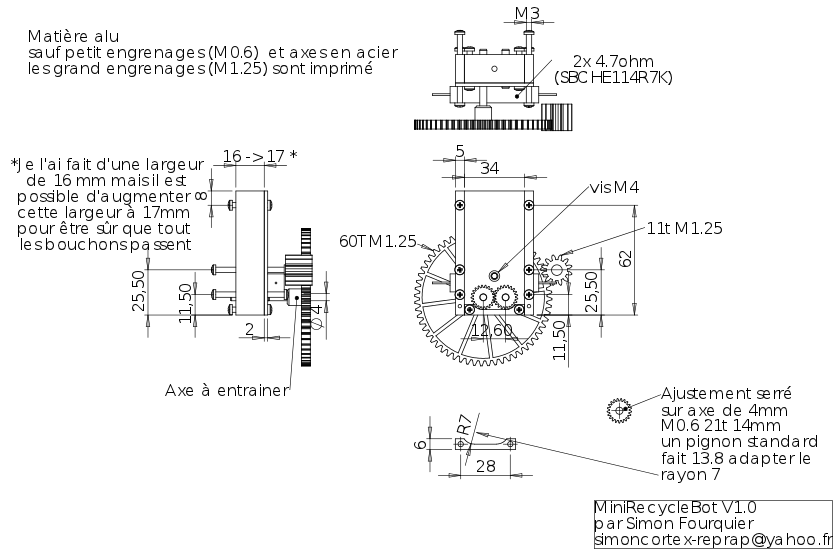MiniRecyclebot
|
English • العربية • български • català • čeština • Deutsch • Ελληνικά • español • فارسی • français • hrvatski • magyar • italiano • română • 日本語 • 한국어 • lietuvių • Nederlands • norsk • polski • português • русский • Türkçe • українська • 中文(中国大陆) • 中文(台灣) • עברית • azərbaycanca • |
This page is under construction. The main version is in French.
Contents
MiniRecyclebot
The MiniRecyclebot is a smaller alternative to the Recyclebot that turns plastic caps or other plastics into 2-3 mm filament.
Video
Prototype video: http://www.youtube.com/watch?v=XhsRjhnGQ7s
Operation
The device is based on the principle of a gear pump.
Operation is as follows:
- A hopper is filled with plastic caps (or any recyclable plastic).
- The hopper is heated to ~200°C.
- A gear pump draws the molten plastic downward.
- The molten plastic is drawn through a 3mm tube.
- Finally, the plastic is stretched by a pair of rollers. By adjusting the speed of these rollers, it is possible to control the final diameter of the filament.
Plan
La mécanique
Main filament former
Media:Fondeur.svg Vector graphic drawing (SVG)
It must turn at constant speed. The prototype uses a stepper motor.
Rollers for shaping the final filament
This has not been implemented yet but the principle is straightforward: pull the wire through two rubber wheels. Their speed will be kept constant with the use of stepper motors (see video).
Electronics
Two resistors are used to heat the chamber. If the system is thermally isolated, 60W should suffice. One could use, for example, two ceramic 4.7 ohm resistors (model SBCHE114R7K) at 12 V, which will draw a total of about 5 A. (Beware that some PC power supplies will not handle this load)
A temperature controller is not necessary if insulation and power supply are carefully selected beforehand.
Stepper motor control can be performed from a PC through the parallel port, or from RepRap electronics with the appropriate firmware.
Here(?) is a small C program that controls two A4983 stepper motor drivers from the parallel port of a computer running GNU/Linux.
Plastic testing
Plastics can be identified by their resin identification code.
NYLON
Nylon can release toxic fumes when heated. Without additional information it is inadvisable to melt the nylon.
NOT TESTED
HDPE
HDPE is used to make some plastic bottles and bottle caps. After forming in the MiniRecyclebot it shrinks by 3% to 3.5%.
Results:
- Good filament extrusion
- Diameter constant to +/- 10%
- Small impurities led to small burnt patches on the filament. These do not affect performance but are unsightly.
- Large deformation during printing.
LDPE
Le PELD est utilisé pour les bouchons d'eau plate ou autres boissons non gazeuse avec un petit bouchon. Malheureusement ce n'est pas toujours le cas c'est parfois du PEHD.
Taux de retrait élever 1.6% à 3%.
Résultats des tests avec le prototype et d'impression
- Bon résultats
- Diamètre du file constant +-10%.
- Petit impureté dût au plastique qui brûle sur les parois mais les impuretés sont souple et passent dans la buze du reprap elles sont par contre inesthétique.
- Impression testée sur une petite pièce creuse 3x2x3cm, bon résultat. Aucun teste n'é été fait avec de plus grande pièces
PP
Boite en plastique, bouchon de grand diamètre et fin (bouteille de lait).
Les 1er tests ont échoués. Diamètre de sortie irrégulier. Quand il est fondu il ressemble à du chewing gum et n'est pas bien pompé. Il faudrait tester à plus haute température
Taux de retrait 1.5% à 2.2%
PS
Pas encore testé
Taux de retrait non trouver mais le HIPS et le GPPS sont entre 0.3% et 0.6%
ABS
Souvent utilisé dans les repraps
Pas encore testé
Taux de retrait faible 0.3% à 0.8%
PLA
Souvent utilisé dans les repraps
Pas encore testé
Il semble ne pas pauser de problème de retrait comme les autres plastique durant l'impression. De plus il est biodégradable
PET
Ne fonctionne pas réagit bizarrement quand on le chauffe il devient blanc et solide
Contact
Liens externe
- PEHD http://fr.wikipedia.org/wiki/PEHD
- PELD http://fr.wikipedia.org/wiki/Poly%C3%A9thyl%C3%A8ne_basse_densit%C3%A9
- Code d'identification des résines http://fr.wikipedia.org/wiki/Code_d%27identification_des_r%C3%A9sines
- source des taux de retrait http://www.thermoformage.com/moules-a-thermoformer
